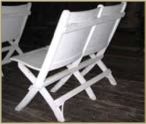
out on the court for the plays, meetings, etc. These wooden chairs were double, side-by-side, seats. I never saw this style of chairs any place else other than a museum. They were reasonably heavy but also reasonably comfortable.
In the southwest corner there was a flight of narrow steps that went half-way up along the west wall and then turned to the left along the south wall and continued to the back of a three or four row set of bleachers that comprised the balcony. At the middle of this balcony was a room that was designed as a projector room. This room was unused except for storage of a few items and was also kept locked except for the most unusual of times. At the east end of the balcony there was a door that opened onto the second floor of the main part of the school; this door too was kept locked except for times the balcony was being used. I think the teachers made an effort to keep youngsters from using the balcony because the railing in the front row was built quite low so spectators could see more of the floor. I think the railing was only about two feet high and it would have been quite easy to fall over it. It was quite often a “great joke” when someone was going along the walkway next to this railing for a friend to grab an arm and give a shove and scare the person into believing they were going to fall over. In my twelve years at Milford, I never heard of anyone falling over it or being hurt from “leaving” the balcony. On rare occasions guys would leap over it or hang from the pipe that went along the top of the railing and drop to the floor.

There was an emergency door on the west end of the gym after one went through the door at the west side of the stage and into a little hall, turn right and one headed toward the stage, straight ahead to the girl's shower or turn left and up a few steps to the emergency door. Woe to anyone who used this door. Or even acted as though they were going to use this door.
Our team played in a gym (Napier?) one evening that was longer than ours but the ceiling was so low that the fellows couldn't shoot from much further than the top of the key without the ball hitting the ceiling which I recall was automatically out of bounds. That gym was so narrow that three of our bigger players could almost reach across it. It was only about 20-22 feet wide.
The Milford floor itself was a hardwood floor that had a couple dead spots. I still remember one that was in the northeast corner. There was a red line completely around the court that was three feet in from the wall or the out of bounds area. This was the line behind which the defensive player had to stand when the ball was “in-bounded”. Obviously, there was no three point line but our fellows would set out in the area 22 to 25 or so feet and put up one-hand set shots and if they were “on” would hit two or three out of the five attempts. The lane under the bucket was only six feet wide as opposed to the current 12; but it seemed as though the refs watched the three-second limit of time an offensive player could be in this zone more than they do now. The top of the free throw circle was about a foot and a half from the center jump circle where there was the letter “M” (orientated to be read from the south) painted on the floorThe baskets were installed about three feet out from the wall with four pipes holding the backboard. For me, this helped on defense. For some reason I felt as though my man couldn't get away from me as easily even though the spacing was the same as when the basket was suspended from the ceiling. The latter arrangement seemed to open the court more even though the measurements were the same. This was the greatest difference for me when playing on a larger court, more so than even the floor's greater length. We were in good shape so the length of the court didn't seem to bother too much. A college sized court, though, did have a noticeable effect on the endurance.